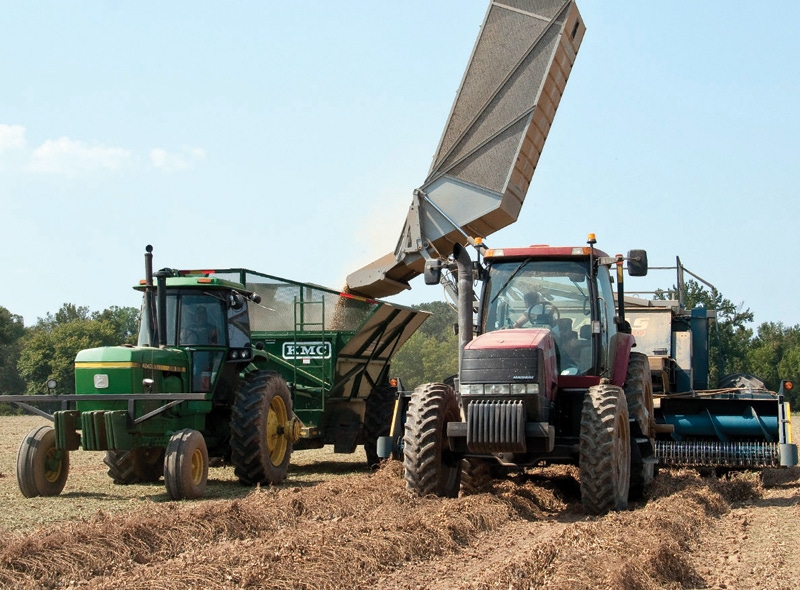
Peanut farmers and other associated industry representatives attending the Southern Peanut Growers Conference in Panama City, Fla., expressed some optimism for the 2011 peanut crop and prices, along with concerns about the ongoing drought in the Southwest, reduced acreage across the peanut belt and also hopes that recent rains across the Southeast will continue until harvest.
Marshall Lamb, research leader, with the USDA-ARS National Peanut Research Laboratory in Dawson, Ga., says the 2011 peanut crop year has been “interesting.”
The Southwest is “in a long drought and Texas has a huge acreage reduction,” Lamb said. “The Southeast crop started out slow with a lot of drought early,” but recent rain has generated some optimism. “We’ve moved from a situation of cautious pessimism to cautious optimism. Southeast growers have a better attitude because of recent rainfall.”
“If this conference had been three weeks earlier, it would have been a poor conference,” said Randy Griggs, executive director, Alabama Peanut Commission. “Recent rains in the Southeast have meant a much better attitude.
“We didn’t get the stands we like to have by this time of year, but with recent rains we have potential for a much better crop than we did a month ago.”
Southwest farmers, he said, remain stuck in a long-term drought and need rain soon.
Tyron Spearman, editor of Peanut Marketing New, said prospects for a good 2011 crop remain uncertain. “The jury is still out. The Southwest is still very dry, and the Southeast has been dry but has received some rain recently, so conditions are looking better. We are optimistic that we’ll make a good crop if we can get rains between now and harvest time.”
Uncertainty is keeping contract offerings at an all-time high.
“Prices are still strong because of supply and demand,” Lamb said. “Demand for peanut products is increasing.” He said quality problems with the 2010 crop in the Southeast kept a lot of peanuts out of the edible market. “Growers have benefitted from higher prices.”
Few growers are signing contracts now but prefer to “wait and see” what might be available at harvest, Lamb said.
“Supply has tightened up,” said Spearman. “We had a shortage last year, and we have reduced acreage this year. We’re not sure of the acreage but we think it’s around 10 percent less than last year, and demand is up 10 percent so we need the peanuts.”
Some estimates indicate Texas peanut farmers reduced acreage by 50 percent and much of the remaining crop remains in jeopardy to drought.
Griggs said peanut demand, coupled with a short 2010 crop and continuing questions about 2011 production, has bolstered contract prices to record levels. “Demand for peanuts remains good,” he said. “Acreage is down. We’ve seen a strong demand for cotton, and a lot of farmers in the Southeast shifted acres from peanuts to cotton.”
He said that strong demand for peanut products likely will carry over into next year. “We’re optimistic that we’ll have strong contract prices into 2012.”
The industry doesn’t just rely on weather conditions and crop prospects to maintain demand, however. George Jeffcoat, an Alabama peanut farmer and chairman of the National Peanut Board, said promotion is a key aspect of the NPB mission.
He said a new advertising campaign capitalizes on consumers’ focus on health and nutrition. “They are interested in such issues as nutrition and anti-oxidants. Peanuts are a good source of protein at a reasonable price. That’s why peanut sales are up.”
He said NPB also partners with other groups, such as pear and apple associations, to provide information about nutritious, economical foods.
“We also work with food editors to get articles about peanuts in national magazines. And we work with a lot of chefs. If we can get them to use peanuts in their dishes we increase sales.”
Jeffcoat and Lamb also commented on the need for peanut research.
Research efforts to improve varieties and production efficiency are key goals for NPB
Research priorities
Jeffcoat said 20 percent of peanut farmers’ checkoff dollars go back to participating states for production research. “It’s always been our long-range plan to use research dollars to increase growers’ profits.”
Those funds are particularly important now, he added, since university research funds have been cut significantly in recent years. “We hope these (NPB) funds will fill the gap,” he said.
Variety development is one of the most critical research efforts. “Improved varieties would be my first priority for research. We want varieties that work better for us,” Jeffcoat said.
Lamb is interested in water.
“Water use efficiency is the number one priority for research,” he said. “That’s especially true with the drought in Texas.”
He said Texas growers should be able to make more peanuts with the same amount of water or the same amount of peanuts with less water.
But water issues are not unique to the Southwest. “We have intermittent drought in the Southeast as well.”
He said “anything we can do to reduce the cost of production,” will be a research priority. Genetics will play a big role in improving efficiency, he said. Varieties with improved disease resistance and other production advantages will be part of ongoing research and breeding efforts. “Improved genetics will be critical.”
Lamb said looking into nutriceutical aspects of peanut breeding will also be important. “We know peanuts are excellent sources of protein and a good bang for the buck for Moms, but we want to increase vitamins and minerals and get nutriceutical characteristics in peanuts.”
Griggs said conference organizers were more than pleased with conference turnout and participation in educational opportunities.
“We are very pleased,” he said. “Turnout is exceptional with more than 600 registered. We have a strong program with presentations from research to economic trends to industry information on the current crop and last year’s crop and the effect on consumption.”
About the Author(s)
You May Also Like






